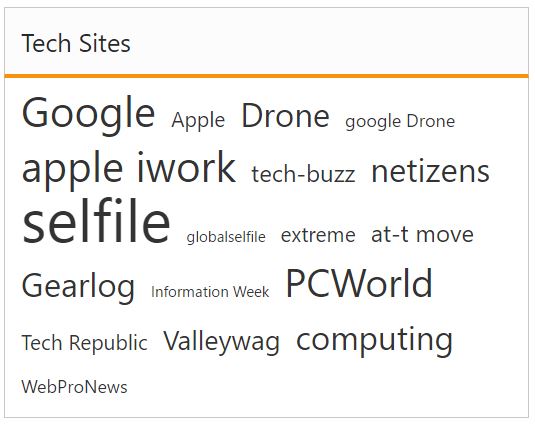Getting Started with ASP.NET Core TagCloud
30 Apr 20219 minutes to read
This section explains briefly about how to create a TagCloud in your ASP.NET Core application.
Create your first TagCloud in ASP.NET Core
ASP.NET Core TagCloud provides support to display a weighted list, where the weight of each item is reflected by the size of the item’s text. TagCloud is rendered as a link and as you click it, you can drill into the selected category. Refer the following guidelines to create TagCloud scenario. This allows you to display a weighted list.

In the above screenshot, you can see the weighted list and a click on any item drills into the respective category.
Create a TagCloud
Essential Studio ASP.NET Core TagCloud widget has built-in features such as clicking on one of the sites in the TagCloud brings all relevant results only from the selected source. You can easily create the TagCloud widget element as follows.
1.Create an ASP.NET Core Project as given in ASP.NET Core documentation
2.Add the following code to the corresponding view page to render TagCloud.
/*ej-Tag Helper code to render TagCloud*/
<ej-tag-cloud id="techWebList" dataSource="ViewBag.datasource" title="Tech Sites" >
<e-tag-cloud-fields text="text" frequency="frequency" />
</ej-tag-cloud>/*Razor code to render TagCloud*/
@{Html.EJ().TagCloud("techWebList").Datasource((IEnumerable<WebsiteCollection>)ViewBag.datasource).TagCloudFields(tag => tag.Text("text").Url("url").Frequency("frequency")).Title("Tech Sites").Render();}3.Add the following style to show the weighted list.
<style type="text/css">
#techWebList
{
margin: 0 auto;
}
</style>NOTE
To render the TagCloud Control you can use either Razor or Tag helper code as given in the above code snippet.
Set the Min and Max Font Size
Create the class for WebsiteCollection and define the necessary data members. Add the following code in WebsiteCollection.cs part.
// Define local data source elements with fields
public class WebsiteCollection
{
public string text { get; set; }
public string url { get; set; }
public int frequency { get; set; }
}You can set the minimum and maximum font size in frequency property by adding the following code example in the Controller.
//Refer the Model in the controller
using <Applicationname>.Models;
public ActionResult Index()
{
List<WebsiteCollection> sites = new List<WebsiteCollection>();
sites.Add(new WebsiteCollection { text = "Google", url = "http://tech.firstpost.com/tag/google", frequency = 12 });
sites.Add(new WebsiteCollection { text = "Apple", url = "http://tech.firstpost.com/tag/apple-iwork", frequency = 3 });
sites.Add(new WebsiteCollection { text = " Drone ", url = "http://tech.firstpost.com/tag/drone", frequency = 8 });
sites.Add(new WebsiteCollection { text = "google Drone", url = "http://tech.firstpost.com/tag/google-drones/", frequency = 2 });
sites.Add(new WebsiteCollection { text = "apple iwork", url = "http://tech.firstpost.com/tag/apple-iwork", frequency = 12 });
sites.Add(new WebsiteCollection { text = "tech-buzz", url = "http://tech.firstpost.com/tag/tech-buzz", frequency = 5 });
sites.Add(new WebsiteCollection { text = "netizens", url = "http://tech.firstpost.com/tag/netizens", frequency = 8 });
sites.Add(new WebsiteCollection { text = "selfile", url = "http://tech.firstpost.com/tag/selfie", frequency = 20 });
sites.Add(new WebsiteCollection { text = "globalselfile", url = "http://tech.firstpost.com/tag/nasa-globalselfie", frequency = 1 });
sites.Add(new WebsiteCollection { text = "extreme", url = "http://www.extremetech.com/", frequency = 3 });
sites.Add(new WebsiteCollection { text = "at-t move", url = "http://www.extremetech.com/extreme/182815-att-moves-to-acquire-directv-to-defend-against-comcast-everyone-loses", frequency = 5 });
sites.Add(new WebsiteCollection { text = "Gearlog", url = "http://www.gearlog.com/", frequency = 9 });
sites.Add(new WebsiteCollection { text = "Information Week", url = "http://www.informationweek.com/", frequency = 0 });
sites.Add(new WebsiteCollection { text = "PCWorld", url = "http://www.pcworld.com/", frequency = 11 });
sites.Add(new WebsiteCollection { text = "Tech Republic", url = "http://techrepublic.com/", frequency = 3 });
sites.Add(new WebsiteCollection { text = "Valleywag", url = "http://valleywag.gawker.com/", frequency = 6 });
sites.Add(new WebsiteCollection { text = "computing", url = "http://www.extremetech.com/category/computing", frequency = 9 });
sites.Add(new WebsiteCollection { text = "WebProNews", url = "http://www.webpronews.com/", frequency = 2 });
ViewBag.datasource = sites;
return View();
}
Set an event to perform operation
You can perform the event operations like MouseOver, MouseOut and Click by adding the following code example inside View page.
/*ej-Tag Helper code to render TagCloud*/
<ej-tag-cloud id="techWebList" dataSource="ViewBag.datasource" title="Tech Sites" click="onclick" create="oncreate" mouse-out="onmouseout" mouse-over="onmouseover">
<e-tag-cloud-fields text="text" frequency="frequency" />
</ej-tag-cloud>
<div id="tagCloudTarget">
<ul>
<li>mouseover</li>
<li>mouseout</li>
<li>click</li>
</ul>
</div>
<ej-drop-down-list id="selectControls_input" change="evtpropscheckedevent" target-id="tagCloudTarget" show-checkbox="true" check-all="true"></ej-drop-down-list>/*Razor code to render TagCloud*/
@{Html.EJ().TagCloud("techWebList").Datasource((IEnumerable<WebsiteCollection>)ViewBag.datasource).TagCloudFields(tag => tag.Text("text").Url("url").Frequency("frequency")).Title("Tech Sites").Render();}
<div id="tagCloudTarget">
<ul>
<li>mouseover</li>
<li>mouseout</li>
<li>click</li>
</ul>
</div>
@{Html.EJ().DropDownList("selectControls_input").TargetID("tagCloudTarget").ShowCheckbox(true).CheckAll(true).ClientSideEvents(evt => evt.Change("evtpropscheckedevent")).Render();}
<style type="text/css">
#techWebList
{
margin: 0 auto;
}
</style>
<script>
function evtpropscheckedevent(args)
{
tagObj = $("#techWebList").data("ejTagCloud");
if (args.isChecked)
{
switch (args.selectedText)
{
case "mouseover": tagObj.option(args.selectedText, "onmouseover"); break;
case "mouseout": tagObj.option(args.selectedText, "onmouseout"); break;
case "click": tagObj.option(args.selectedText, "onclick"); break;
}
}
else tagObj.option(args.selectedText, null);
}
function oncreate(args)
{
alert("Tagcloud has been created.");
}
function onmouseover(args)
{
alert("Mouse pointer is hovered on " + args.value);
}
function onmouseout(args)
{
alert("Mouse pointer is hovered awayfrom " + args.value);
}
function onclick(args)
{
alert( args.value + " is clicked.");
}
</script>When you move the mouse to latest technology (weighted) list, it is denoted in Alert box. You can execute the above code to render the following output.
